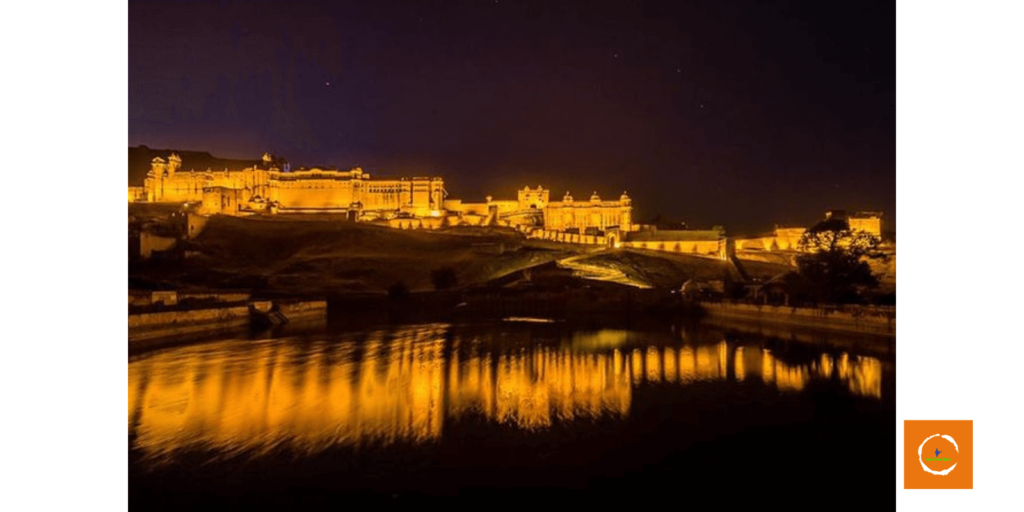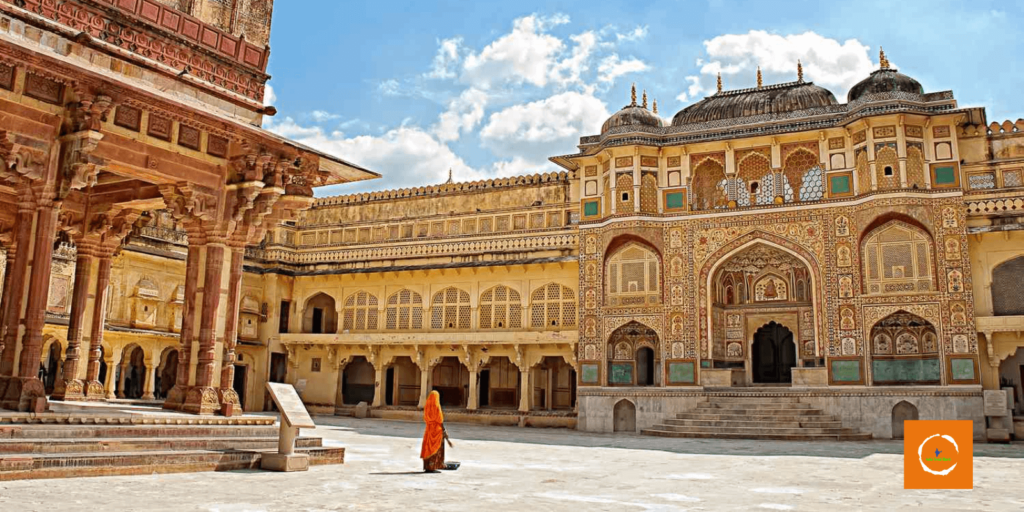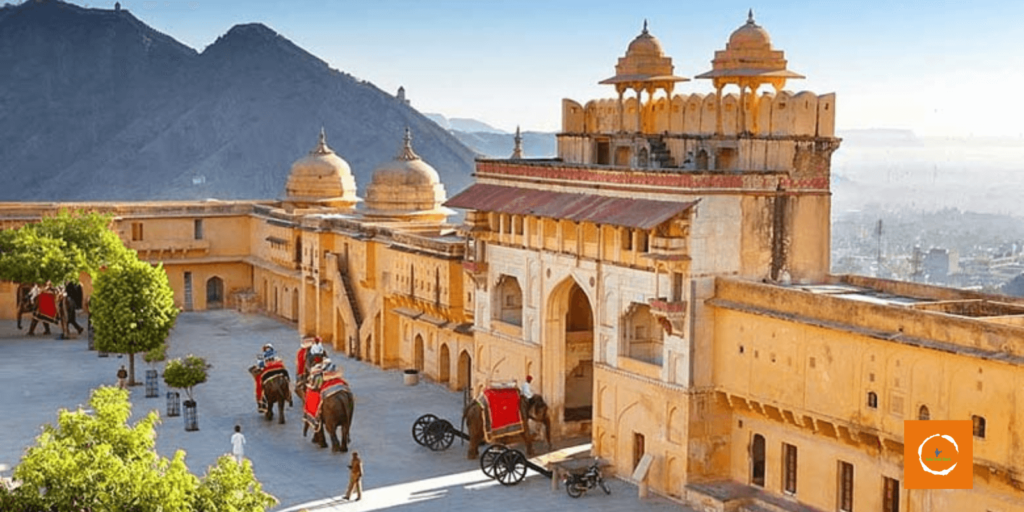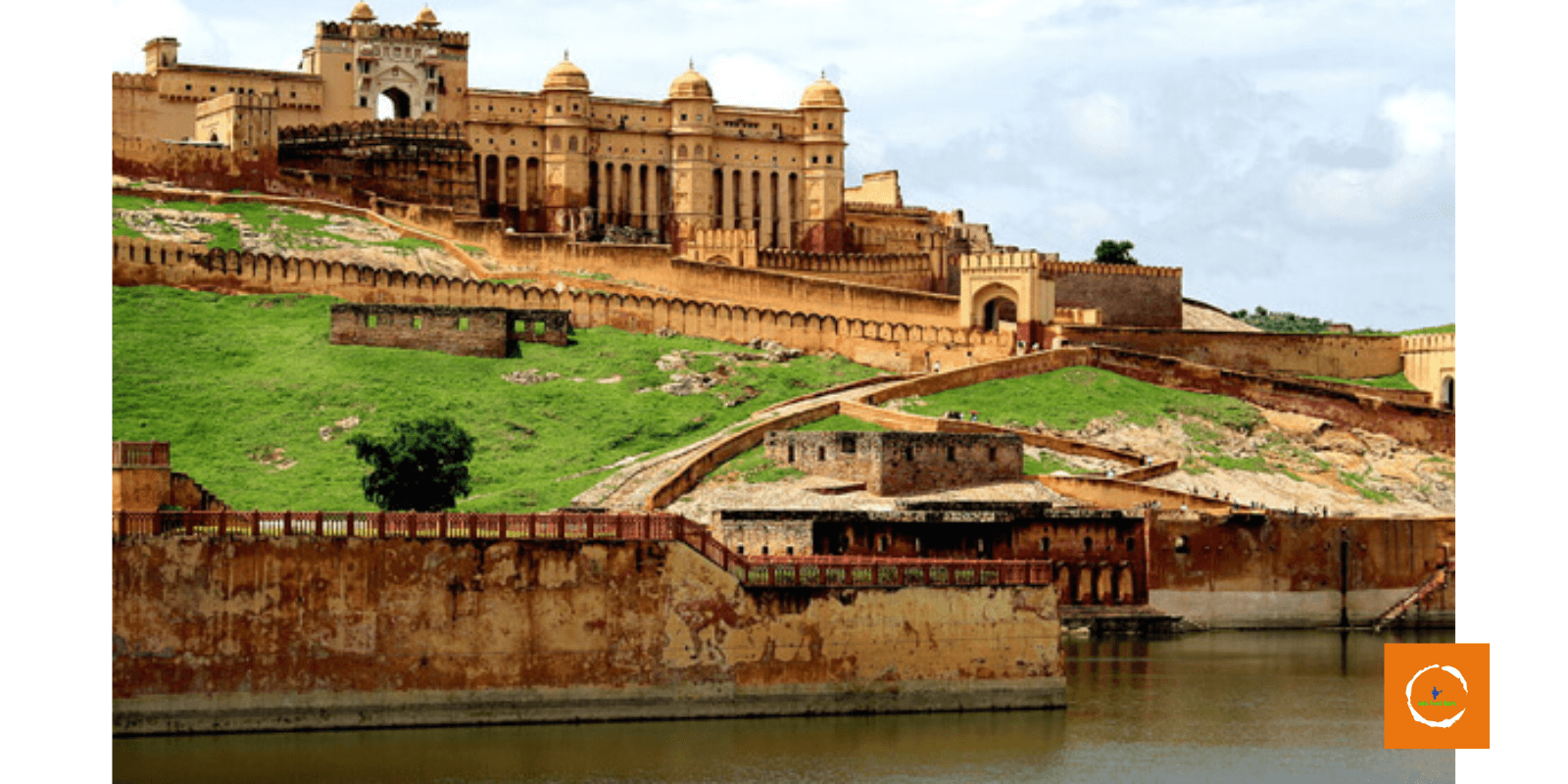Introduction
In the heart of Jaipur, India, lies a treasure trove of history and architectural splendour known as Amber Fort in Jaipur. This majestic fortress, perched atop a rugged hilltop, has stood as a testament to the grandeur of Rajasthan’s past for centuries. Its origins trace back to the 16th century when it was built by Raja Man Singh I, a trusted general in the court of Emperor Akbar.
Amber Fort, also known as Amer Fort, served as the stronghold of the Kachhawa Rajputs, who ruled the region with valour and distinction. Over the years, it evolved into a symbol of the Rajputana glory, showcasing a remarkable fusion of Rajput and Mughal architectural styles. The fort’s imposing walls, intricately carved pillars, and ornate palaces reflect the artistic prowess of the craftsmen who laboured to bring the king’s vision to life.
Stepping into Amber Fort is like stepping back in time, as visitors are greeted by a panorama of opulent palaces, serene courtyards, and imposing gates. Each corner of the fort whispers tales of valour, romance, and royalty, transporting visitors to a bygone era of chivalry and grandeur.
But beyond its architectural splendour, Amber Fort holds a deeper significance in the history and culture of Jaipur. It served as the capital of the Kachhawa dynasty for centuries, witnessing the rise and fall of kings, the ebb and flow of empires, and the enduring spirit of the Rajput warriors.
Today, Amber Fort stands as a testament to Jaipur’s rich heritage, drawing visitors from far and wide to marvel at its beauty and immerse themselves in its storied past. As we embark on a journey to explore this historical gem, we will uncover the secrets of its architecture, unravel the tales of its rulers, and bask in the timeless charm of Amber Fort and the vibrant city of Jaipur.
History and Heritage of Amber Fort in Jaipur

Nestled among the Aravalli Hills, Amber Fort proudly narrates a tale that spans centuries, echoing the valour and grandeur of the Rajputana era. Its story begins in the 16th century, a time when the industrious Raja Man Singh I envisioned a fortress that would not only stand as a symbol of his might but also serve as a formidable defence for his kingdom.
In 1592, the construction of Amber Fort commenced under the watchful eyes of Raja Man Singh I, a trusted general in the court of Emperor Akbar. The fort, initially named “Dhundar,” was strategically perched on a hill, offering both a commanding view of the surrounding landscape and a natural defence against potential invaders. As the years unfolded, successive rulers added their touches, embellishing the fort with intricate details and expanding its majestic presence.
The fort’s architecture mirrors the amalgamation of Rajput and Mughal styles, a testament to the harmonious coexistence of diverse cultural influences. The robust, sandstone walls stand as a testament to Rajput’s strength and resilience, while the delicate marble carvings and ornate courtyards showcase the finesse of Mughal craftsmanship. This fusion of styles creates a unique and awe-inspiring atmosphere, transporting visitors to a time when artistic collaboration flourished.
Amber Fort’s historical tapestry is woven with threads of triumphs and challenges. It served as the capital of the Kachhawa Rajputs for several generations, witnessing the rise and fall of rulers, the splendours of victories, and the sombre echoes of defeats. The fort, a silent witness to countless moments in history, endured the test of time, silently guarding the legacy of its builders.
One cannot explore the history of Amber Fort without encountering the tales of legendary Rajput warriors who graced its corridors. The fort’s defences were tested during battles, and its majestic halls hosted royal celebrations and strategic discussions. The Sheesh Mahal, with its mirrored splendour, reflects not only the artistic brilliance of the craftsmen but also the opulence of the Rajput court.
As the centuries rolled on, Amber Fort witnessed the ebb and flow of empires, transitioning from Rajput rule to becoming part of the larger canvas of Indian history. The fort survived the ravages of time, changing hands and enduring transformations, yet retaining its regal allure.
Today, Amber Fort stands not just as a historical relic but as a living testament to the enduring spirit of Rajputana. Visitors who traverse its courtyards and ascend its ramparts can almost hear the whispers of the past, feel the pulse of battles, and witness the majesty of a bygone era.
The journey through Amber Fort’s history is a captivating exploration of resilience, cultural fusion, and the everlasting legacy of the Rajputana heritage.
Related Reads: 7 Amazing Things about Rambagh Palace in Jaipur, India
Architectural Marvels
Embarking on a journey through the architectural marvels of Amber Fort is like stepping into a living canvas where the brushstrokes of Rajput and Mughal influences create a masterpiece that stands the test of time. This grand fortress, nestled among the hills of Jaipur, unfolds a captivating saga of artistic brilliance and cultural fusion.
The fort’s exterior, characterized by sturdy sandstone walls that seemingly touch the sky, reflects the robust Rajput architecture. The strategic location on a hilltop was chosen not only for its defensive advantages but also for the breathtaking views it offered. The fort’s imposing entrance, known as the Sun Gate or Suraj Pol, welcomes visitors with a sense of awe and anticipation, setting the stage for the architectural wonders that lie within.
As one steps into the heart of Amber Fort, the fusion of Rajput and Mughal styles becomes evident in every nook and cranny. The Diwan-i-Aam, or Hall of Public Audience, stands as a testament to the Mughal influence. This grand hall, adorned with ornate pillars and arches, served as a platform for the ruler to address the public. The intricately carved jharokhas (balconies) provide a glimpse into the refined Mughal craftsmanship, creating an atmosphere of regal splendour.
One cannot traverse Amber Fort without being captivated by the enchanting Sheesh Mahal, or Palace of Mirrors. This gem within the fort is a dazzling display of artistic finesse. Thousands of tiny mirrors adorn the walls and ceilings, reflecting candlelight to create a mesmerizing play of light. The Sheesh Mahal was not only a place of visual enchantment but also served a practical purpose, providing the royal family with a respite from the scorching Rajasthan sun.
Ganesh Pol, another jewel in the architectural crown of Amber Fort, is a gateway that leads to the private quarters of the rulers. This structure stands as a testament to Rajput’s engineering and artistic prowess. The gate is adorned with intricate frescoes and floral patterns, and the central archway is crowned by an image of Lord Ganesh, the remover of obstacles, signifying a divine blessing for those who pass through.
The fort’s courtyards, such as the Jaleb Chowk and Saffron Garden, offer a respite from the grandeur, providing a glimpse into the daily life within the fort. These open spaces, surrounded by colonnades and adorned with fountains, add a touch of serenity to the architectural spectacle.
Amber Fort’s architectural narrative is a harmonious blend of Rajput strength and Mughal elegance. It speaks volumes about the cultural exchange that took place during the construction, resulting in a structure that transcends time and continues to awe visitors from around the world.
Each arch, pillar, and courtyard tells a story of artistic collaboration, cultural syncretism, and the enduring legacy of a bygone era. As visitors explore these architectural wonders, they find themselves immersed in a living history, where the past resonates in every stone and carving.
A Virtual Tour

Embarking on a virtual tour of Amber Fort is an enchanting journey through time, where every step unveils the architectural splendours and historical tales woven into the fabric of this majestic fortress. Let’s explore this regal gem together, discovering its must-see spots, hidden gems, and panoramic views that transport visitors to a bygone era.
1. Sun Gate (Suraj Pol): Begin your virtual journey at the Sun Gate, also known as Suraj Pol. Imagine the anticipation as you pass through this grand entrance, feeling the cool breeze and catching a glimpse of the breathtaking landscape beyond. The sturdy sandstone walls stand tall, hinting at the robust Rajput architecture that guards the fort.
2. Jaleb Chowk: Step into the Jaleb Chowk, the main courtyard, where the air is filled with a sense of festivity. This open space was once a venue for grand ceremonies and military parades. Visualize the hustle and bustle of the past as you walk through this historic courtyard.
3. Ganesh Pol: Your journey takes you to Ganesh Pol, a gate adorned with vibrant frescoes and intricate floral patterns. The central archway, crowned by an image of Lord Ganesh, invites you into the private quarters of the rulers. Pause to admire the architectural finesse and imagine the significance of this sacred gateway.
4. Diwan-i-Aam (Hall of Public Audience): Step into the grandeur of the Diwan-i-Aam, where rulers held court and addressed the public. Picture the ornate pillars and arches, each telling a story of Mughal influence. Envision the ruler’s presence, commanding attention from the elevated platform, and absorbing the regal atmosphere that once filled this hall.
5. Sheesh Mahal (Palace of Mirrors): Prepare to be dazzled as you enter the Sheesh Mahal, the Palace of Mirrors. Marvel at the thousands of tiny mirrors adorning the walls and ceilings, reflecting a kaleidoscope of light. Visualize the royal family basking in the ethereal glow, surrounded by the intricate craftsmanship that makes this palace truly magical.
6. Hidden Gems: As you explore further, discover hidden gems tucked away in the corners of the fort. Imagine stumbling upon quiet alcoves, secret passages, or forgotten chambers, each with its own story to tell. These hidden treasures add an element of mystery and intrigue to your virtual tour.
7. Strategic Vantage Points: Climb to strategic vantage points within the fort, such as the walls and watchtowers, to soak in panoramic views of the surrounding landscape. Picture yourself surveying the vast expanse, appreciating the foresight of the fort’s architects in choosing such an advantageous location.
Cultural Insights
Embarking on a journey through the cultural landscape of Amber Fort unveils a captivating tapestry woven with vibrant threads of celebrations, festivals, and traditions. This regal fortress, nestled in the heart of Jaipur, not only stands as a testament to historical grandeur but also serves as a pulsating hub for cultural events that breathe life into its ancient stones.
Cultural Events and Festivals
Amber Fort, like a lively canvas, comes alive during various cultural events and festivals, inviting locals and visitors alike to partake in the joyous celebrations. Among the vibrant festivities, the Elephant Festival takes centre stage, turning the fort into a spectacle of colours and sounds.
Picture this: majestic elephants adorned with ornate decorations parading through the courtyard, accompanied by traditional dances and music. The air is filled with excitement as locals and tourists join in the revelry, immersing themselves in the rich cultural heritage of Rajasthan.
Adding to the enchantment is the Diwali Festival, the Festival of Lights, which bathes the fort in a warm, luminous glow. As the sun sets, the entire fortress twinkles with the brilliance of countless lamps and candles. The festivities include traditional performances, fireworks, and an atmosphere of jubilation that resonates within the historic walls of Amber Fort.
Significance in Local Traditions
Beyond the grandeur of special events, Amber Fort is deeply ingrained in the local traditions and celebrations of Jaipur. It has been a silent witness to centuries of royal gatherings and intimate ceremonies, forging an inseparable link between the fort and the cultural identity of the region.
During the Teej Festival, the fort takes on a unique charm as women don traditional attire, adorned with vibrant bangles and intricate mehndi designs. They gather at Amber Fort for processions and cultural performances, infusing the air with the spirit of Teej. The fort, with its regal ambience, becomes a canvas where the vibrant traditions of the festival unfold, creating a colourful spectacle that mirrors the essence of local customs.
Amber Fort also plays a pivotal role in the celebration of various cultural performances, showcasing the rich tapestry of Rajasthan’s artistic heritage. Imagine the resonance of classical Rajasthani music echoing through the courtyards, creating an immersive experience for both locals and visitors. The fort transforms into a cultural oasis, where traditional dances, music, and theatrical arts come together, fostering a deep appreciation for the region’s artistic legacy.
Moreover, the fort serves as a conduit for cultural education and exploration, hosting exhibitions and art installations that delve into the historical and cultural roots of Jaipur. It stands not only as a historical monument but as a dynamic space where the past converges with the present, inviting everyone to be part of the living heritage of the region.
Also Read: Exciting Places to Visit in Jaipur for Couples
Practical Tips for Visitors

Embarking on a visit to Amber Fort promises an exciting adventure into the heart of history, and a few practical tips can turn your experience into a seamless and enjoyable journey. Let’s dive into some straightforward advice to make the most of your time at this enchanting fortress in Jaipur.
Best Times to Visit
Choosing the right time for your Amber Fort expedition can make a big difference. Aim for the cooler months, usually from October to March, when the weather is more pleasant. This way, you can explore the fort comfortably without the scorching heat of summer. The cooler temperatures will allow you to fully immerse yourself in the beauty and history of this majestic site.
Ticket Information
Before venturing to Amber Fort, it’s essential to get the lowdown on ticket details. Entrance fees can vary for different visitors, like foreigners and locals. Keep an eye out for any extra charges, especially if you plan to bring along a camera or shoot videos. To save time and avoid queues, consider buying your tickets online or in advance. It’s a small step that can contribute to a hassle-free entry experience.
Transportation Options
Getting to Amber Fort can be part of the adventure itself. Jaipur’s city centre is around 11 kilometres away, and you have various transportation options. Auto-rickshaws and taxis are readily available, providing a convenient way to reach the fort. For a touch of regal flair, you can opt for an elephant ride up the hill to the fort’s entrance. Keep in mind that the availability of elephant rides depends on weather conditions and conservation efforts, so it’s wise to check in advance.
Guided Tours
Enhance your Amber Fort experience by considering a guided tour. Local guides are well-versed in the stories and details of the fort, offering valuable insights that add depth to your exploration. Guided tours often include fascinating anecdotes and lesser-known facts, making your visit more engaging and informative. It’s an excellent way to fully appreciate the historical and architectural significance of Amber Fort.
Exploring the Fort
Once you step into Amber Fort, take your time exploring its various sections. Start with the expansive courtyards and gradually make your way to the intricately designed palaces and halls. Don’t miss the Sheesh Mahal, a palace adorned with thousands of tiny mirrors that create a captivating effect. Capture the breathtaking views from the fort’s vantage points, allowing you to appreciate the natural beauty surrounding the fortress.
Nearby Attractions and Activities
Complement your Amber Fort experience by exploring nearby attractions that showcase the cultural richness of Jaipur. Jaigarh Fort, located nearby, offers another historical gem known for its impressive cannon foundry and stunning views of the Aravalli Range. Hawa Mahal, the Palace of Winds, is another must-visit site with its unique honeycomb-like facade.
Take a stroll through the lively markets of Johari Bazaar and Bapu Bazaar for a taste of local craftsmanship. Here, you can find vibrant textiles, traditional jewellery, and handicrafts that make for excellent souvenirs. Don’t forget to indulge in the local cuisine by sampling Rajasthani specialities at nearby eateries.
As you conclude your visit to Amber Fort, take a moment to absorb the regal ambience and reflect on the historical significance of this architectural marvel. With these practical tips, you can ensure a memorable and stress-free exploration of Amber Fort and its captivating surroundings.
Personal Experiences
Embarking on a journey to Amber Fort is not just about exploring historical architecture; it’s a voyage filled with personal stories and enchanting encounters. Here, we delve into the experiences of fellow travellers, weaving a tapestry of relatable moments that connect us through the magic of this majestic fortress.
1. Awe-Inspiring Views:
John, an avid traveller, shared his awe-inspiring experience as he reached the highest point of Amber Fort. Standing on the ancient walls, he marvelled at the panoramic views of the Aravalli Range and the surrounding landscape. The vastness and serenity of the scene left him breathless, contemplating the centuries of history that unfolded beneath his gaze. It’s a sentiment many visitors share – that overwhelming sense of wonder when nature and history converge in such a breathtaking way.
2. Elephant Ride Adventures:
Samantha, a solo traveller with a passion for unique experiences, recounted her adventure of ascending the fort on the back of an elephant. The gentle sway and rhythmic steps of the majestic creature added an extra layer of magic to her journey. The camaraderie formed during that short ride with her newfound pachyderm friend became a cherished memory, emphasizing the unforgettable nature of such encounters.
3. Tales of Sheesh Mahal’s Radiance:
The allure of Sheesh Mahal, the Palace of Mirrors, touched the heart of Lisa, a history enthusiast. As she stepped into the sparkling chamber, the reflections of countless mirrors created a dreamscape of light and beauty. Lisa shared how, for a moment, she felt transported to an era of opulence and regality, where the walls whispered tales of grandeur and romance. It’s a sentiment that resonates with many who have been captivated by the ethereal charm of Sheesh Mahal.
4. Cultural Celebrations:
Mark, a traveller passionate about immersing in local cultures, happened upon Amber Fort during the Diwali Festival. The entire fort was aglow with the warm hues of lights and lanterns, creating an atmosphere of joy and festivity. Mark described the experience of witnessing traditional dances, tasting local delicacies, and feeling the rhythmic beats of celebrations as an unexpected highlight of his journey. Such cultural encounters add a layer of authenticity to the Amber Fort experience, connecting travellers with the vibrant traditions of Jaipur.
5. Moments of Serenity:
Emma, a nature lover, found solace within the quiet corners of Amber Fort’s courtyards. Away from the bustling crowds, she discovered hidden nooks where she could simply sit, absorb the historical energy, and appreciate the timeless beauty that surrounded her. These moments of serenity amidst the historical grandeur became a cherished part of Emma’s travel memories, offering a different perspective on the fort’s allure.
FAQ’s
1. What is Amber Fort famous for?
- Answer: Amber Fort is renowned for its historical significance, stunning architecture, and its role as the former capital of the Kachhawa Rajputs.
2. When was Amber Fort built?
- Answer: Construction began in 1592 by Raja Man Singh I, a trusted general in Emperor Akbar’s court, and it continued to evolve over the years.
3. How far is Amber Fort from Jaipur?
- Answer: Amber Fort is approximately 11 kilometres away from Jaipur, making it a short journey by car, auto-rickshaw, or an adventurous elephant ride.
4. Can I visit Amber Fort all year round?
- Answer: While you can visit Amber Fort throughout the year, the best time is from October to March, when the weather is more comfortable.
5. Are there guided tours available at Amber Fort?
- Answer: Yes, guided tours are available. Local guides can provide fascinating insights into the fort’s history, architecture, and stories.
6. What are the must-see attractions inside Amber Fort?
- Answer: Key attractions include the Sheesh Mahal (Palace of Mirrors), Ganesh Pol (Ganesh Gate), and Diwan-i-Aam (Hall of Public Audience).
7. How much is the entry fee to Amber Fort?
- Answer: Entry fees vary for different visitors. It’s advisable to check the latest ticket information and any additional charges for cameras or videos.
8. Can I explore other places near Amber Fort?
- Answer: Yes, nearby attractions include Jaigarh Fort, Hawa Mahal, and bustling markets like Johari Bazaar and Bapu Bazaar.
9. Are there special events or festivals at Amber Fort?
- Answer: Yes, Amber Fort hosts cultural events and festivals like the Elephant Festival and Diwali Festival, providing a unique and immersive experience.
10. Can I purchase souvenirs near Amber Fort?
- Answer: Absolutely! Nearby markets offer a variety of souvenirs, including traditional textiles, jewellery, and handicrafts, allowing you to bring home a piece of Rajasthan’s vibrant culture.
Conclusion
In conclusion, the enchanting journey through Amber Fort unfolds as a mesmerizing tapestry of history, culture, and architectural brilliance. From the regal courtyards to the intricate palaces, every step within the fort whispers tales of a bygone era, inviting visitors to immerse themselves in the grandeur of Rajasthan’s past. The panoramic views from strategic vantage points, the shimmering beauty of Sheesh Mahal, and the echoes of cultural celebrations create an unforgettable experience. Amber Fort stands not just as a fortress of stone but as a living testament to the rich heritage of Jaipur.
As we conclude this journey, the invitation is extended to each reader to embark on their adventure to this historical gem. The allure of Amber Fort transcends words, and the exploration promises discoveries beyond imagination. From the regal gates to the hidden corners, every inch of the fort is a testament to the artistry and resilience of the Rajputana heritage. So, pack your curiosity and set forth on a voyage to Amber Fort, where the past and present converge in a celebration of timelessness and cultural richness. The echoes of history await, and the enchantment of this majestic fortress beckons for your exploration.
Related Read: 7 Exciting Places to Visit in Jaipur City
Image Credit : Wallpaper Cave
